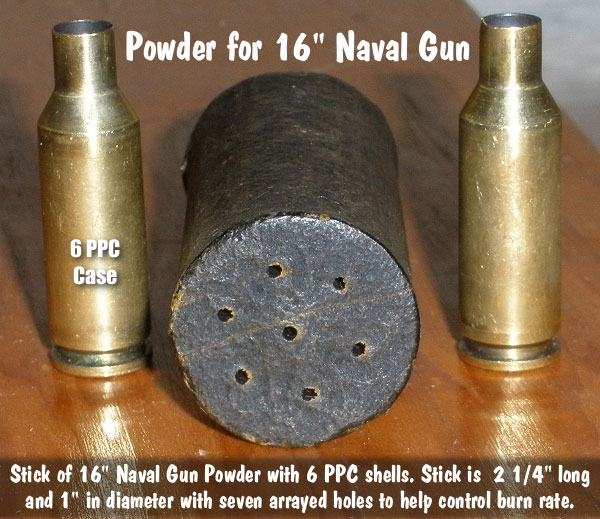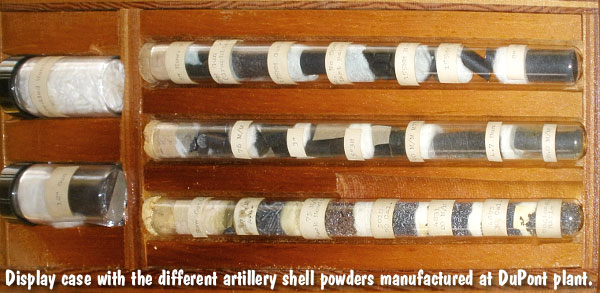Don’t Try to Trickle These Sticks… Powder for Big Naval Guns

Story by Boyd Allen
While many top competitive shooters trickle their stick powder charges to a kernel or two, that would be impractical when loading charges for giant naval guns. You may be surprised, but the shells fired by the U.S. Navy’s massive 14″ and 16″ naval guns were also propelled by stick-type extruded powders. You couldn’t trickle these ‘kernels’ though — a single stick or ‘grain’ can be over 2″ long. Take a look…
In connection with a Benchrest Central discussion that drifted to the subject of powders used in large naval guns, I heard from Joe McNeil, whose father was involved in manufacturing those very propellants as a DuPont employee. Joe writes:
“My Dad worked for the DuPont company for over 40 years. Every time the nation went to war he was assigned to the gun powder plants which DuPont ran for the government for $1.00 per year! His last assignment was at the Indiana Ordnance Plant in Jefferson, Indiana from 1952 through 1958. He had a display case made of all of the different powders made at the plant and left it to me. That’s why I have a grain of 16″ gun powder. He took me out to the Jefferson proving grounds once when they tested the powder in a 16″ gun. We watched from a half-mile away but it left a lasting impression when they fired that gun. They actually had a set of rings they fired through to test the performance of the powder and shell. This was a truly fond memory of my Dad and his work.”
Here are some pictures of the gun powder “grains” made during the Korean War at the Indiana Ordnance Works where Joe McNeil’s father worked.


Above is the display case with the different powders manufactured at the DuPont plant. They include: 37 MM/AA, 75MM Pack Howitzer, 50 Cal. 5010, 20 MM 4831, 30 Cal. 4895, 76 MM, 3″, 5″, 90 MM, 4.7″, 240MM, 8″, 280 MM, 175 MM, 155 MM Howitzer, 155 MM Gun M.P., 8″ Gun M.P., 12″, 14, 16″. There are different-sized ‘grains’ for specific rounds.


















Boyd,
That’s an interesting article. I was a civilian engineer at the Naval Ordnance Station Louisville, KY where the engineers in charge of the guns were based. The Powder Plant was in Jeffersonville,IN a few miles from Louisville. The powder was put into bags made of cotton,I believe, that were sewn at the powder plant and charges were loaded into the guns in increments of those bags of powder. My understanding was that the gunnery officer using the gun fire control system would determine the number of bags required and then give loading orders to the gun crew in the turret(s). I suppose when you are shooting a projectile that is 16 in. dia. and about 5 ft. tall one does not have to be quite as precise as your typical competitive shooter loading fixed ammunition. Thanks for the article.
TA
One of the fondest memories of my route to becoming a Navy officer was my instructor for the Gunnery and Fire Control course, a wise, experienced Senior Chief (started in WWII), who had battleship experience and who led us through the care and feeding of 16″ naval rifles as a matter of historical interest. None of us (probably including Chief Bowling) realized that they would be back for Viet Nam service shortly after we graduated. Tom’s comments above are accurate; to elaborate on them, the 16 inch projectiles weighed in at 1800-2200 lbs, depending on the purpose, and many types were closer to 6 feet tall than 5 if memory serves. Gross range adjustment was indeed established by varying the number of bags (6 max, again if memory serves), and each bag had a small pouch affixed to the back end that contained black powder to force proper ignition. When the last bag was put in the breech, a gunner slit that pouch just before the breech block was closed.
As far as long range accuracy was concerned, the better chief gunner’s mates were pretty phenomenal – my cousin, an armored type, once remarked that they liked to be operating their tanks close enough to the VN coast for a Navy battleship to offer artillery support if they had problems. One of his fellow tankers got in a big problem about 11 miles inland and the New Jersey was about 4 miles off the coast. They were advised to hold on tight, and the New Jersey Gunners proceeded to lay down a donut with a hole about 60 yards in diameter with their tank in the middle of the hole. They were well and truly shaken up by the explosions, but the brief barrage of 16 inch high explosive projectiles from miles away ended the threat in about 3 seconds. Apparently, this sort of marksmanship was the norm the armored guys encountered when they radioed for close support from a battlewagon, and was much appreciated.
Mike